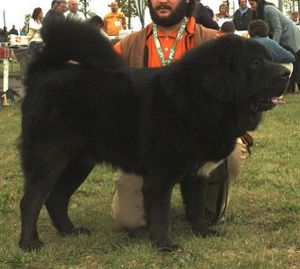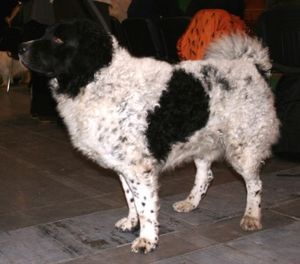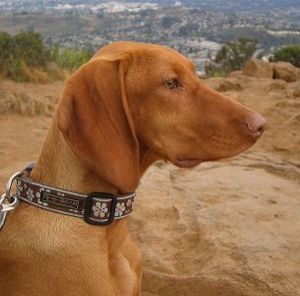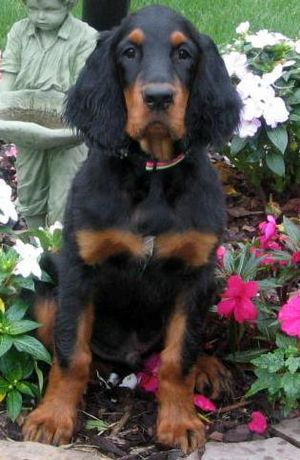 |
| Vital Statistics: |
| Place of Origin: Tibet |
| Group: Working dog, Guard dog |
| Height: males 26 in. min., females 24 in. min. |
| Weight: males 100-160, females 75-120 (Some dogs are close to 200 lbs.) |
| Life span: 10-12 yrs. |
| Trainability: low |
| Good with children: yes but always supervise |
| Good with other pets: with opposite sex dogs, may chase cats |
December’s dog is the Tibetan Mastiff.
This giant who once guarded whole villages now happily loves and protects its family.
What is the origin of the Tibetan Mastiff?
The Tibetan Mastiff is descended from Tibetan dogs who were the ancestors of the majority of Molossuses and mastiffs. The English have perfected the breed and it is no longer the ferocious and aggressive dog it once was.
What does the Tibetan Mastiff look like?
The Tibetan Mastiff is a large, powerfully built dog. It can be as tall as 31 inches and can weigh 75-160 lbs. some even close to 200 lbs. The massive head is wide with powerful jaws. Eyes are medium size, almond shaped and brown. Ears are v-shaped and pendant and carried close to the head. The tail curves over the back and is well feathered. The coat is long, heavy and thick with a heavy, soft undercoat. Colors are black, brown, blue-grey and can have tan or gold areas.
What is the temperament of the Tibetan Mastiff?
The Tibetan Mastiff is very intelligent and can be independent and strong-willed. It is very protective of its family but wary of strangers. Consistency is the key to training the Tibetan Mastiff. With a firm but kind hand, it will learn to see you as pack leader. This dog is not suitable for apartment living and should have a large, fenced-in yard. Fences should be high enough and securely in the ground to avoid the dog escaping. Exercise should consist of daily walks, particularly in wooded areas if available.
What are the uses of the Tibetan Mastiff?
The Tibetan Mastiff is an outstanding sheepdog and protector of the flock. In its native Tibet, this massive dog was used to guard whole villages and will guard and protect its family.
Possible Health Issues
Hip/elbow dysplasia, hypothyroidism, persistent pupillary membrane (eye disorder), inherited demyelinative neuropathy(hypertrophic neuropathy – leads to hindquarters paralysis, no treatment available, fatal)
- Akbash Dog
- Alaskan Malamute
- Anatolian Shepherd Dog
- Appenzell Mountain Dog
- Belgian Malinois
- Boxer
- Burnese Mountain Dog
- Canaan Dog
- Chinook
- Deutscher (German) Pinscher
- Doberman Pinscher
- Dogue de Bordeaux
- Estrela Mountain Dog
- German Spitz (Giant, Standard, Toy)
- Giant Schnauzer
- Great Dane
- Greater Swiss Mountain Dog
- Greenland
- Irish Red & White Setter
- Kai Ken
- Korean Jindo Dog
- Kuvasz
- Laika
- Leonberger
- Newfoundland
- Norwegian Elkhound
- Rat Terrier
- Rottweiler
- Saint Bernard
- Samoyed
- Siberian Husky
- Standard Schnauzer
- Akbash Dog
- Anatolian Shepherd Dog
- Black Russian Terrier
- Boerboel
- Bullmastiff
- Burnese Mountain Dog
- Ca de Bou
- Cane Corso
- Chinese Shar-Pei
- Chow Chow
- Estrela Mountain Dog
- Fila Brasileiro
- Giant Schnauzer
- Great Pyrenees
- Hokkaido Dog
- Kai Ken Dog
- Kangal Dog
- Karelian Bear Dog
- Kerry Blue Terrier
- Komondor
- Kuvasz
- Mastiff
- Neapolitan Mastiff
- Norwegian Elkhound
- Presa Canario
- Pyrenean Mastiff
- Rafeiro do Alentejo
- Rhodesian Ridgeback
- Rottweiler
- Sanshu
- Shikoku Inu
- Tosa Ken



